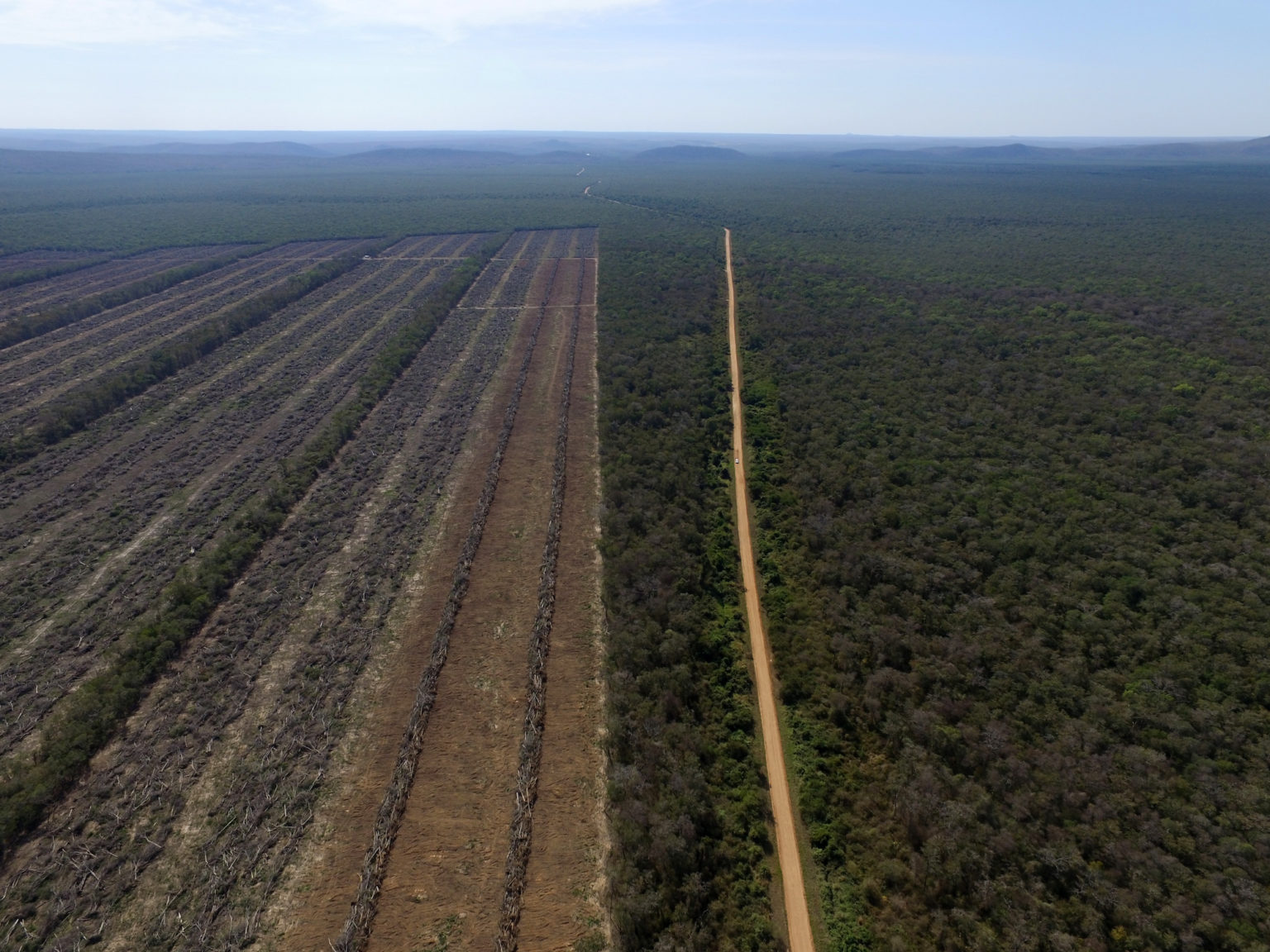Latin America
Related: About this forumBolivia's Deforestation Crisis
13 October 2023 | Photography by Matjaz Krivic
The Bolivian countryside is undergoing radical transformation, critically endangering the region’s rich biodiversity.
Bolivia has the third highest deforestation rate of primary forests in the world, right after Brazil and the Democratic Republic of Congo (DRC). 14% of all the forest has already been lost to industrial agriculture of soy, maize, and cattle ranching. The federal government has encouraged agricultural expansion through subsidies and national pension funds. By 2025, it plans to triple the size of cultivated land and cattle herds. Land in Bolivia is cheaper than in neighbouring countries, and speculation is widespread. Seeking short-term profits, local and foreign buyers fuel the conversion of the country’s tropical forests into savannahs.
As forest fires intensify, the temperatures progressively increase. Communities face repeated droughts while coping with the spread of new diseases.

View of deforested land in the north-east of the Santa Cruz department (eastern Bolivia), where a single tree is left. From 1976 to 2021, Bolivia lost 8.6 million hectares (an area the size of Austria) which is equivalent to 14% of its forests, according to Fundacion Amigos de la Naturaleza (FAN). The country ranks 12th among all countries in biodiversity, but it is rapidly losing its animal and plant species.

The Mennonites colony west of San Ignacio de Velasco uses fire to clear land for agricultural purposes. The intensity of fires has been increasing. The Authority for the Inspection and Social Control of Forests and Land (ABT) admits that from 2012 to 2021, 60% of deforestation was illegal.

View over lines of burned forest, cleared by the new community of ‘interculturales’ in the municipality of San Rafael in eastern Bolivia. The three main deforestation factors are (1) domestic and foreign companies, especially Brazilian ones, (2) immigrants from the highlands of Bolivia who are granted land by the government (campesinos interculturales), and (3) Mennonites – an ultraconservative Christian church community.

Grain silos building site in San Ignacio de Velasco. In the last two decades, the rate of primary forest loss in Bolivia has roughly doubled. The turning point was in 2015 when Evo Morales’ government abandoned an economic model based on oil and natural gas exports and replaced it with the promotion of agriculture and livestock. For this, it needed land in forests and in the territories of indigenous communities. “This is a serious wound in environmental policy, and the result are fires and massive forest loss,” said Gonzalo Colque, executive director of the environmental NGO Fundacion Tierra.

View over soya fields east of Santa Cruz de la Sierra. The main drivers of deforestation in Bolivia are the expansion of areas for soybean production and cattle ranching for domestic consumption and export. In total, as much as 2/3 of the agricultural land is dedicated to cattle breeding or the production of feed for it.

Machine clearing the forest and preparing the land for agriculture near San Jose de Chiquitos in eastern Bolivia. The intensity of deforestation has drastically increased, supported by legislation and government spending.

A portion of forest burns on land rented by Mennonites near Concepcion. Fires in Bolivia account for 1/3 of forest loss per year. In the Chiquitania region, tropical dry forest fires are constant from August to October. With small fines, at $200 per thousand acres burned, the fires pay off for prominent Brazilians and Mennonite landowners. The worsening effects of climate change exacerbate the traditional dry, hot weather, making it more challenging to control the fires. In 2019, more than 5 million hectares of forest was burned – an area bigger than Costa Rica.
More:
https://revolve.media/views/bolivias-deforestation-crisis
Absolutely disgusting. Greed has invaded and claimed Bolivia, abused, mistreated, despised the Native Bolivians, and is hard at work bleeding the country dry.
Bayard
(28,200 posts)They are quasi-Amish. I can't imagine they would be getting into big Ag in South America, especially using such destructive methods.
![]()
Judi Lynn
(164,039 posts)I just found this article from Global Witness, a great source I've seen repeatedly, which discusses the fact that large communities of Mennonites are razing and shredding the bejesus out of the forests, and growing products it sells to enormous operations like US-based Cargill.
I just stumbled onto it, as I've never looked to find out what they're up to before! (I did see a short time ago that a huge number of them originated in Russia and settled all over South America. They have always sought to be isolated from the governing structures and specifically don't want governments to be able to send their sons to the military.)
From the Global Witness article,
SEPT. 6, 2023
Empty promises: Cargill, soy, banks and the destruction of Bolivia’s Chiquitano forest:
~ ~ ~
- snip -
What we discovered
Cargill can be linked to many of the areas identified by Global Witness either directly through its subsidiary Cargill Bolivia, or indirectly through other companies from which other Cargill entities buy soy. Most of the areas visited by our researchers were “colonies” - “colonias” in Bolivian Spanish – owned and farmed by Anabaptist Christian communities called Mennonites, who farm areas sometimes extending for tens of thousands of hectares.
The links between Cargill and these colonies can be proven by receipts bearing the US company’s name that were shown to Global Witness by Mennonites living there and known as “distributors” (“distribuidores”). These small-scale soy industry middlemen work with the farmers, with the seed, pesticide and fertiliser companies, and with the intermediary companies brokering sales to the processing mills and/or exporters and traders like Cargill.

SOURCES: NATURAL EARTH, SENTINEL-2 CLOUDLESS - HTTPS://S2MAPS.EU BY EOX IT SERVICES GMBH (CONTAINS MODIFIED COPERNICUS SENTINEL DATA 2021); HANSEN/UMD/GOOGLE/USGS/NASA, ACCESSED THROUGH GLOBAL FOREST WATCH; YANN LE POLAIN DE WAROUX (2020), HTTPS://DOI.ORG/10.5683/SP2/I4FEQZ
These receipts were issued by Cargill’s silos or other storage facilities linked to the company after the soy has been transported there from the point of harvest. Below is an example of one of the receipts seen and photographed by Global Witness in the five colonies. Table 1 summarises our analysis of these receipts. Most of these areas, according to our analysis, have been deemed more suitable for purposes other than intensive farming by a legally-binding regional government’s land-use plan, known as a “Plan de Uso de Suelo” (PLUS).
Cargill confirmed it does business with all five communities identified by Global Witness. It told us: “We constantly monitor our suppliers and can confirm that the Mennonite communities in question are in compliance with our Police on Sustainable Soy [sic].”
The company said it investigates all allegations received and blocks suppliers if policies and commitments are found to have been violated. The company said it has mapped 26 polygons - a type of farm boundary - across the five Mennonite colonies named by Global Witness and based “on this mapping available and on the mass balance methodology, we can infer that the products received from at least four from the five colonies could be produced in the hectares opened before 2017. Just on the case of one of those communities we cannot assure that the grains were produced on lands deforested before 2017. Which does not necessarily mean that this is non-compliant with the local legislation or Cargill commitments.” Cargill says it works with the Bolivian Soy Roundtable to establish “minimum socio environmental criteria for soy origination in the country”.
Big money
Complicit in Cargill’s Bolivia operations are global banks such as Barclays, BNP Paribas, HSBC and Santander, who have provided financial services to the company worth billions of dollars since 2021 according to the Forests and Finance database. For example, last year Cargill issued bonds worth over US$2 billion which were underwritten by BNP Paribas, Barclays, Santander and Bank of America, among others. In 2021 a consortium including Bank of New York Mellon, BNP Paribas, Deutsche Bank and HSBC arranged a US$6 billion revolving credit facility for Cargill, while that same year Deutsche Bank was also part of a syndicate that provided a US$1.3 billion corporate loan to the company.
These deals were made despite an increasing number of financial institutions apparently becoming more interested in reducing or ending their portfolios’ exposure to deforestation. One example is BNP Paribas. In 2021 it pledged “not to finance customers producing or buying beef or soybeans from land cleared or converted after 2008 in the Amazon”, and by 2025 to require “full traceability of beef and soy (direct and indirect) channels” for all its customers. BNP Paribas told Global Witness it uses this policy and other systems to “identify, assess and manage the environmental and social risks and impacts of the activities of our clients”, noting “we value the information you provided regarding Bolivia as it will inform the discussions we have with our client.”
Such deals were also made despite countless exposés of Cargill’s links to deforestation over the years, going back at least as far as 2016. Greenpeace’s 2006 report Eating up the Amazon identified the company as one of “three U.S.-based agricultural commodities giants at the heart of the Amazon destruction.” There is no way these banks could convincingly claim they were not aware of the deforestation risks when they decided to service Cargill.
Is Cargill deliberately failing to record the origin of its soy?
These receipts obtained by Global Witness not only link Cargill to soy from Mennonite colony properties where forest has recently been cleared, but they also show that the company is failing to record or request exactly where the soy has been grown when it is deposited at the silos and other storage facilities it owns or rents. This information is needed by Cargill to reach its traceability goals and check if the purchased soy is deforestation-free. If it wasn’t for these receipts being shown to us, it would probably be impossible to connect that soy to the company.
More:
https://www.globalwitness.org/en/campaigns/forests/empty-promises-cargill-soy/
~ ~ ~
A brief Wikipedia report on Mennonites in Bolivia:
The Mennonites in Bolivia are among the most traditional and conservative of all Mennonite denominations in South America. They are mostly Russian Mennonites of Frisian, Flemish, and Prussian descent. As of 2013, there were about 70,000 Mennonites living in Bolivia,[2] that population has grown to around 150,000 as of 2023.[1]
More:
https://en.wikipedia.org/wiki/Mennonites_in_Bolivia
~ ~ ~
They are tearing the bejesus out of the vital forest areas, bigger and bigger profits for themselves, at the expense of the Bolivian people. They're vaporizing the forests, using the exposed land for crops, handing the products over to Cargill, etc., with everyone making out like bandits, along with the Bolivian politicians who pave the way for them, and the environment, life on earth, goes directly into the toilet.
Easy to see there's a lot to investigate ahead for more people like those at Global Witness. I hope to learn more, and I hope something will be done in time.
Judi Lynn
(164,039 posts)by Iván Paredes Tamayo on 3 April 2023 | Translated by Matthew Rose

Life goes at its own pace in the town of Chihuahua, where the modern mixes with Mennonite traditions. To one side, horse-drawn carts pull up at a plot of land that stands in the middle of the plain. To the other, an almost-new car parks in front of a chalet-style house. Such is life on this Mennonite colony located in the eastern Bolivian municipality of Cuatro Cañadas.
The colony’s 280 families are considered rebels by other Mennonites, having drifted from the denomination’s strict way of life, which forbids the use of many forms of modern technology. The town’s streets are lined with heavy machinery; residents, many of whom have forgone the traditional Mennonite dress, walk around with mobile phones in their hands.
However, like those of other Mennonite communities in Latin America, Chihuahua’s Mennonite families are masters of agribusiness and soy cultivation — and are continually expanding their industrial farms.

An industrial crop field expands near Lomerío Indigenous Territory. Image by Edwin Caballero.
. . .
More:
https://news.mongabay.com/2023/04/expansion-of-mennonite-farmland-in-bolivia-encroaches-on-indigenous-land/
Bayard
(28,200 posts)These Mennonite sound more like the Amish here, instead of the Mennonites I have met. Most people have the wrong idea about both related divisions. They aren't religions, its a way of life.
They can be as greedy as anybody else from what I've observed in this heavily Amish-populated area of KY. I have met ex-Amish (yes, they exist), who left the lifestyle, saying it was too hypocritical. They askew machinery--unless it is used for, "business purposes." Which means, you will see them farming with a $200,000 tractor during the week, but still driving a horse and buggy to church. There are a couple of Amish grocery stores that have no problem using forklifts and the like. Their houses do not have electricity, but natural gas is a-okay. They carry cell phones.
My horse vet in Calif. was Mennonite. They drive cars, have electricity, etc, and you'd never know any difference, except they are likely to drop their heads with no notice and rattle off a prayer for your welfare.
I see no difference between what they are doing in South America, and what Big Ag does. Its all destroying the planet. I trust the Indigenous people to be good stewards of the land, and truly hope they succeed in this battle. You would think they'd get more legal help from all over the world, considering how essential the Amazon is to life on this planet.
I apologize if I have offended any Amish or Mennonites on this board.
Thanks for these posts, Judi Lynn. You do a great job of educating DU about what's going on in the rest of the world.
![]()
Duppers
(28,457 posts)GOOD! They deserve to be!
![]()